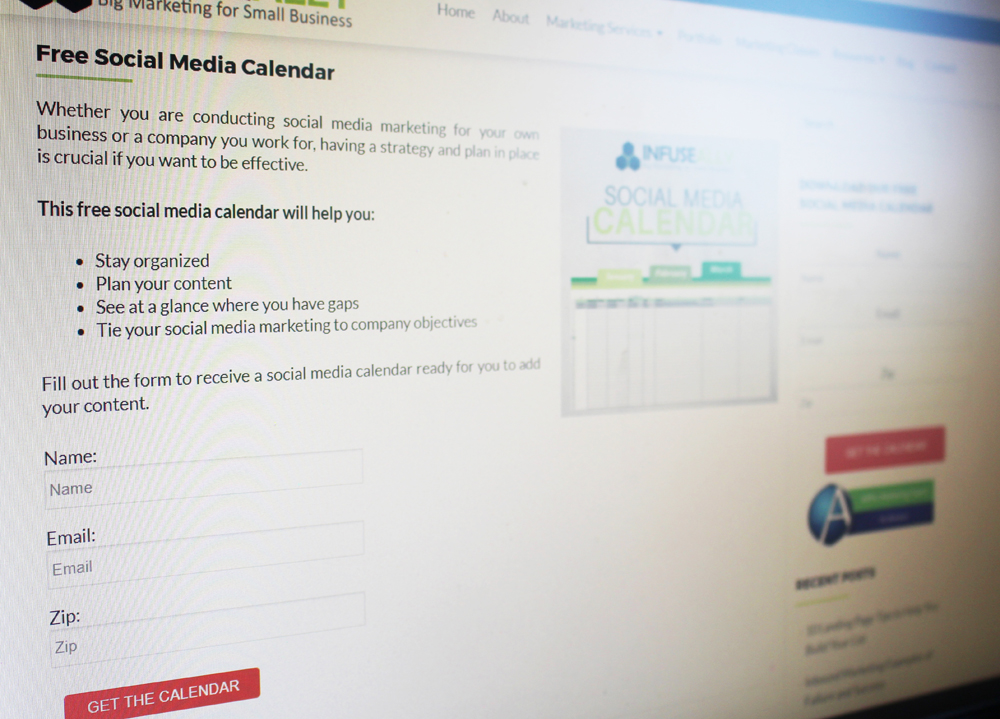How and Why You Need to Create Your Own Landing Pages
Thursday July 20, 2017
If you've built your small business from the ground up, you likely gained your initial clients through networking, word of mouth and referrals. But if you want to grow beyond your face-to-face network you need to generate leads from your website as well. Successful entrepreneurs know how to optimize their websites for search engines to bring prospects to their website. They also know how to convert those visitors into leads by creating landing pages. If you need to create your own landing pages, or you wonder what they are and why they are important, this post is for you.

Why Create Your Own Landing Pages
When a visitor first lands on your website, they are rarely ready to make a purchase. Instead, they first want to learn more about who you are and what you do to determine whether or not you can help them with their needs. Usually, you are one of several companies the prospect is evaluating before making a decision to buy. This decision-making process can be lengthy for some prospects, while for others, they may make a purchase decision within a couple of minutes. If you don't know who that prospect is you can't match your solutions to their needs and you have to rely solely upon your website to provide everything they are looking for.
If a prospect doesn't find what they need in a few brief minutes (or seconds), they will leave your site and give their business to a competitor. In most cases, they will never return, and you won't even know who they are! This is why landing pages can be so useful. They can help convert anonymous visitors on your website into known leads that you can follow up with and build a solid reputation with over time.
The best way to identify anonymous website visitors is by giving them something valuable in exchange for their contact information. As a small business owner, you are an expert at what you do and you likely have information that would be valuable to people who are visiting your website. If you take that information and package it into an ebook, guide, checklist or other useful tool, you now have something you can give away on your website for free in exchange for contact information. In order to do this you need to create your own landing pages.
What Does a Landing Page Look Like?
Landing pages come in all shapes, sizes and price ranges as some landing pages offer the free content we just mentioned, while others promote a product or program for a price. What you create depends on your marketing goals.
You have probably encountered tens, if not hundreds of landing pages over the years without even realizing it. Some examples include:
- Webinar sign ups
- Ebook giveaways
- Contest registrations
- Newsletter subscriptions
- Free guides and information
- Free trials
The list goes on and on. But landing pages are not exclusively for giving away free content. While landing pages are a great way of building your list through giving away something for free, they can also be used to sell a specific program or service. To call a page a "landing page" merely means that it is a page you can market by itself to drive people to that specific URL. It is the first page a visitor "lands on" when they visit your site. However, one of the best uses of landing pages is for lead generation to convert anonymous website visitors into known leads in the process previously discussed. For further direction on what a good landing page looks like, read this article for landing page tips to help you build your list.
What Type of Landing Pages to Create
Generally speaking, your landing pages should fall into one of the following categories:
- Top of funnel - for people unfamiliar with your brand who are looking for solutions to a problem
- Middle of funnel - for people who have identified you as a possible solution and are trying to decide between you and your competitors
- Bottom of funnel - for selling products and services to people who are ready to make a purchase
Depending on which group you are targeting, the landing pages you set up will be different, but here's a general rule:
- Top of funnel landing pages should provide free content that specifically addresses the visitor's problems while showcasing your knowledge and expertise.
- Middle of the funnel landing pages should provide an opportunity for prospects to learn more about you on a deeper level through webinars or comparison guides.
- Your bottom of the funnel landing pages should contain compelling offers that encourage prospects to make a purchase.
You need a good mix of all three types of landing pages in order to adequately move your website visitors toward making a purchase decision. The idea is to present top of funnel landing pages to new website visitors in order to identify who they are so you can continue marketing to them slowly over time. These top of funnel landing pages should dominate the majority of your landing pages as they exist primarily to capture as many online leads as possible in an effort to drive them toward making a purchase later on. Middle and bottom of the funnel landing pages should be introduced only after you have build a relationship with your prospects.
If you need some help thinking through your landing page strategy, contact one of our AllPro Marketing Experts for help.
What You Need to Create Your Own Landing Pages
Do not confuse landing pages with contact pages. A contact page contains a form that simply alerts the website owner when someone fills it out. Most every website platform has this functionality. However, a contact form is one-directional - it sends information back to the website owner but does not provide anything to the person filling out the form. If you want to give something away while capturing contact information in the process, you need more than just a contact form. You need specific technology that allows you to redirect visitors to a thank you page where they can access the content you are giving away. Additionally, a best practice is to also send the visitor a welcome email with the same content provided on the thank you page.
There are a number of programs that offer landing page building tools and they vary in price and functionality. Typically, you'll spend between $30-$300 per month to create your own landing pages and you will be required to pay annually. If you pay month to month the cost will go up. AllProWebTools offers you this functionality with no contracts, on a month-to-month basis for $30 per month and includes integrated email marketing and a robust Customer Relationship Management tool (CRM), so you don't have to export contacts from your landing page software into your email marketing software, and you always know what each contact is doing.
Most landing page technologies allow you to use their tools to create landing pages outside of your website, with complicated steps to integrate the pages onto your website's URL. The problem with these options is that if you ever want to stop using their service, you will lose your landing pages and will have to rebuild them on another platform. With AllProWebTools, the sign up forms can be embedded within the pages of your website. So if you have your website on Wordpress, your landing pages can be built right within your Wordpress site. Read this blog for detailed instructions on How to Create Landing Pages Using AllProWebTools' Land Page Tools.
Landing pages are an invaluable tool for your business when used correctly and they can multiply your leads. For more information about how to create your own landing pages using AllProWebTools, or strategies on how to best set them up, contact one of our AllPro Experts today.


